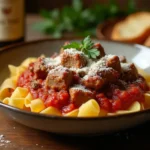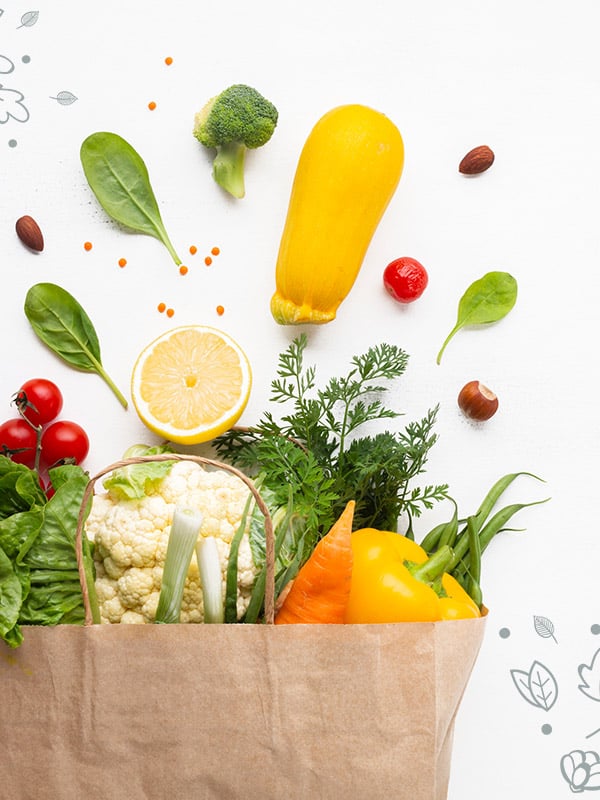Choosing the right canned Salmon for your salmon loaf can be challenging. You’ll often find red sockeye salmon and pink Salmon. But which one is best for your recipe? We’ll look at the differences between these two, covering their taste, texture, and health benefits.
Table of Contents
Key Takeaways
- Understand the distinct characteristics of red Sockeye and pink canned Salmon, including their flavour, texture, and nutritional differences.
- Explore how the choice between red and pink Salmon can affect the binding properties, cooking time, and overall quality of your salmon loaf.
- Discover the price point considerations and value assessments to help you make an informed decision on the best canned Salmon for your budget and recipe needs.
- Learn about the comparative nutritional benefits of red and pink Salmon, such as their omega-3 content and protein levels.
- Gather tips on the best practices for preparing a delicious and moist salmon loaf, regardless of the canned salmon variety you choose.
Understanding Canned Salmon Varieties for Your Loaf Recipe
Choosing the right canned Salmon is essential to a tasty salmon loaf. Wild-caught and farm-raised Salmon differ in nutrition and taste. Knowing these differences helps you pick the best for your recipe.
Wild-Caught vs. Farm-Raised Salmon
Wild-caught Salmon comes from the ocean, offering a bold taste and firm texture. This is because they live in their natural habitat. Farm-raised Salmon, on the other hand, tastes milder and is softer.
Key Nutritional Differences
Wild-caught salmon has more omega-3 fatty acids, which is good for your heart and brain. Farm-raised Salmon might have more saturated fat due to its diet and living space.
Processing Methods and Quality Standards
The canning process affects salmon quality. Wild-caught Salmon is canned more carefully, keeping nutrients and flavours intact. Farm-raised Salmon, while cheaper, might lose some of its nutritional value during canning.
| Attribute | Wild-Caught Salmon | Farm-Raised Salmon |
|---|---|---|
| Flavor | Robust, distinct | Mild, subtle |
| Texture | Firm, flaky | Soft, delicate |
| Omega-3 Content | Higher | Lower |
| Canning Process | Rigorous, preserves nutrients | Less stringent, may lose some nutrients |
Understanding the differences between wild-caught and farm-raised Salmon helps you choose. It’s about finding the right balance of taste, texture, and nutrition for your salmon loaf.
Red Sockeye Salmon: Premium Choice for Salmon Loaf
Red sockeye salmon is the top pick for making a tasty salmon loaf. It’s known for its deep colour and fantastic flavour. This fish gives a unique taste experience that’s different from other canned Salmon.
Sockeye salmon, or red Salmon, is loved for its firm texture and spicy taste. It has a unique flavour that goes well with the ingredients in a salmon loaf. Its oily flesh makes it feel rich in your mouth, and its bold taste blends well with the other parts of the dish.
Red sockeye salmon is also excellent for your health. It is rich in omega-3 fatty acids, protein, and essential minerals. These nutrients make it a healthy choice for your salmon loaf.
| Nutrient | Sockeye Salmon | Pink Salmon |
|---|---|---|
| Omega-3s (g) | 1.5 | 0.7 |
| Protein (g) | 22 | 20 |
| Selenium (mcg) | 41 | 32 |
Choosing red sockeye salmon for your salmon loaf makes a big difference. It’s a top choice for anyone who loves to cook or enjoy great food.
Pink Salmon: The Budget-Friendly Alternative
Red sockeye salmon is often seen as the top pick for a salmon loaf. But pink Salmon is a cheaper option that’s worth considering. It has a unique taste and is easy to work with in the kitchen. This makes it an excellent choice for those looking to save money on salmon recipes.
Flavor Profile and Texture
Pink Salmon tastes milder than red Salmon. It’s also softer, which is perfect for those who like a lighter salmon flavour. Even though it’s not as strong as red Salmon, pink Salmon’s soft taste works well with many seasonings and cooking methods.
Common Uses in Cooking
Pink Salmon is very flexible in salmon loaf recipes. Its mild taste and soft texture are great for many dishes. Here are some examples:
- Salmon patties
- Salmon cakes
- Salmon salads
- Baked or grilled salmon loaf
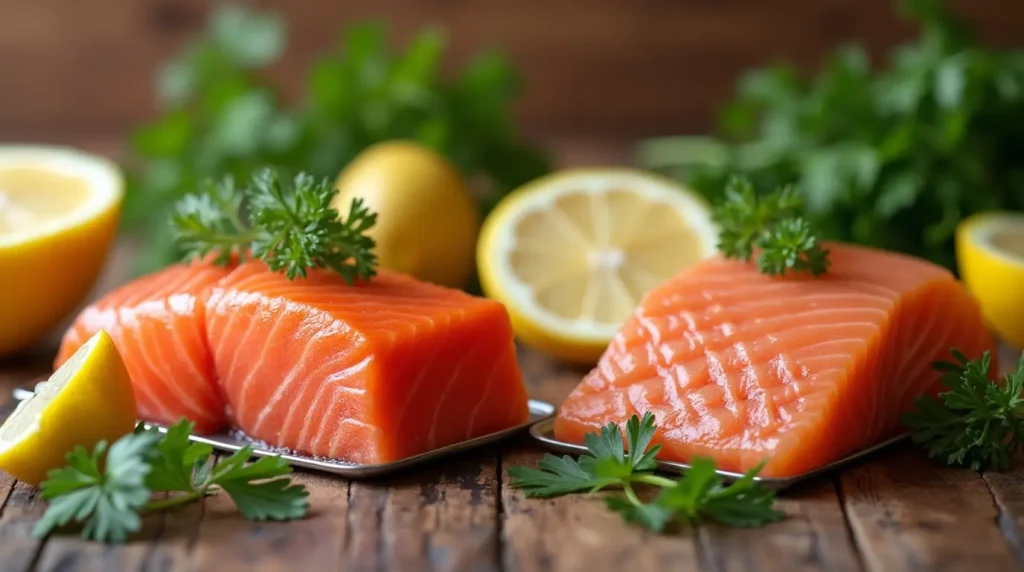
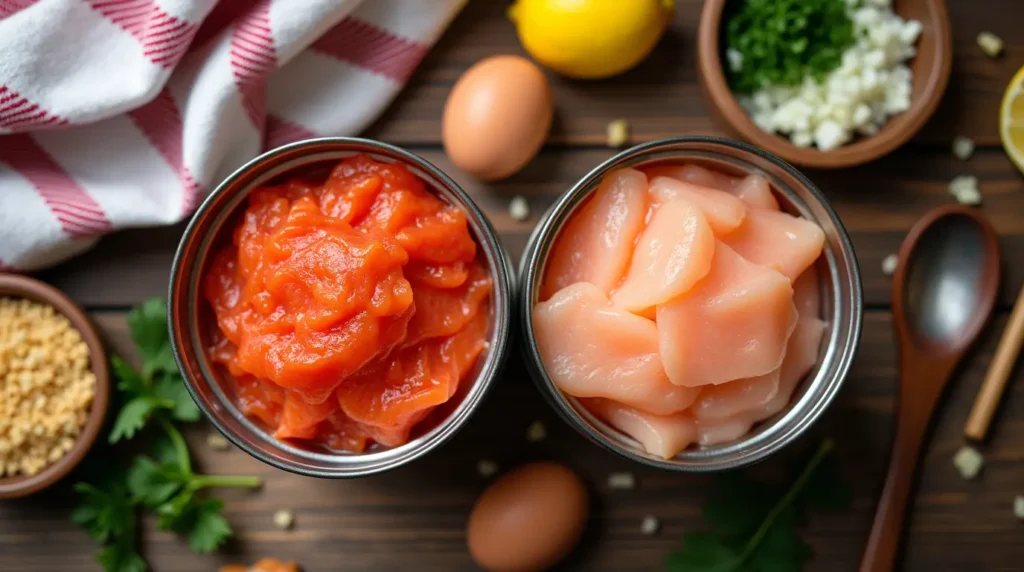
Price Point Considerations
Pink Salmon is much cheaper than red Salmon. This makes it an excellent choice for saving money on seafood. It’s perfect for those who want to cut costs without losing out on taste or quality.
| Salmon Variety | Average Price per Can (15 oz) |
|---|---|
| Red Sockeye Salmon | $4.99 – $6.99 |
| Pink Salmon | $2.49 – $3.99 |
Red vs Pink Canned Salmon for Loaf: Key Differences
When picking the best canned Salmon for your salmon loaf, knowing the differences between red and pink is critical. Let’s explore what makes these two options unique.
The main difference is the salmon species. Red Salmon, or sockeye salmon, is loved for its bright colour and intense flavour. Pink Salmon, however, has a milder taste and a lighter colour.
When making a salmon loaf, consider these points:
- Texture: Red Salmon is firmer and flakier, helping the loaf stick together. Pink Salmon makes the loaf softer and more delicate.
- Flavour: Red Salmon’s bold taste adds depth to your loaf. Pink Salmon’s milder flavour makes for a more subtle dish.
- Appearance: Sockeyeye salmon’s bright red colour makes your loaf look stunning. Pink Salmon gives it a softer, pinkish-beige look.
Choosing between red and pink canned Salmon for your loaf depends on your taste and goals. Both can make your dish delicious. Knowing their differences helps you pick the best for your recipe.
Texture and Moisture Content: Impact on Your Loaf
Creating a tasty salmon loaf depends on the fish’s texture and moisture. Knowing the differences between red and pink canned Salmon is critical to a great loaf.
Binding Properties
The salmon texture is essential for holding ingredients together. Red Salmon, like Sockeye, is firmer and flakier. This makes it a better binder for your loaf.
Pink Salmon, however, is softer and more delicate. Extra binding agents, like breadcrumbs or eggs, might be needed to keep the loaf together.
Cooking Time Variations
The fish moisture content affects how you cook your salmon loaf. Red Salmon, being denser, might need a bit more Time to cook through.
Pink Salmon, being softer, cooks faster. It’s important not to overcook it to avoid dryness.
| Attribute | Red Salmon | Pink Salmon |
|---|---|---|
| Texture | Firm and flaky | Soft and delicate |
| Binding Properties | Stronger binding agent | May require additional binding agents |
| Cooking Time | Slightly longer | Shorter |
Understanding the differences between salmon texture and fish moisture content helps you make better choices. This ensures your salmon loaf turns out delicious.
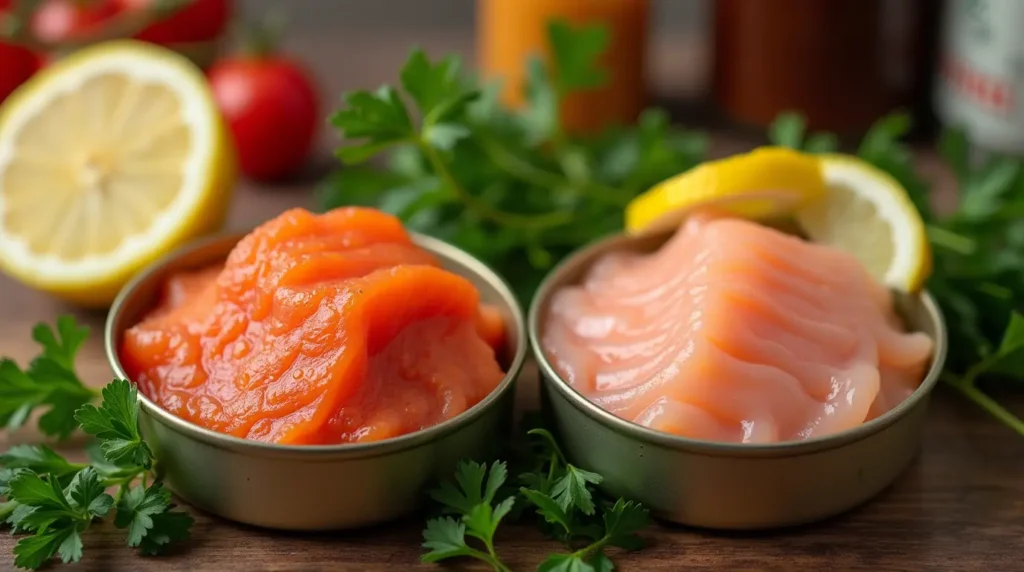
Price Comparison and Value Assessment
Choosing between red sockeye salmon and pink canned Salmon for your salmon loaf is a big decision. Price is a crucial factor to consider. Let’s look at the salmon prices and see which one offers the best value for money.
Red sockeye salmon is known for its rich flavour and firm texture. It usually costs more than pink Salmon. A 14.75-ounce can of red Sockeye can cost between $3.50 and $5.00. Pink Salmon, on the other hand, is cheaper, costing between $2.00 and $3.50.
But, we should look at more than just the price. Red sockeye salmon might be worth the extra cost because of its better quality and nutrition. This can make your salmon loaf taste better and be more satisfying. Pink Salmon is still a great choice if you’re on a tight seafood budget or need to feed a big group.
| Canned Salmon Variety | Average Price Range (14.75-oz can) | Potential Benefits |
|---|---|---|
| Red Sockeye Salmon | $3.50 – $5.00 | Richer flavor, firmer texture, higher quality |
| Pink Salmon | $2.00 – $3.50 | More budget-friendly, suitable for larger servings |
Choosing between red and pink canned Salmon for your salmon loaf depends on your preferences and budget; consider the number of servings you will be providing. Evaluate the cost differences and the value each option presents. This will help you choose the best option for your cooking needs.
Nutritional Benefits: Comparing Red and Pink Salmon
Choosing the right Salmon for your loaf can significantly impact its nutritional value. Let’s explore the main differences between red and pink Salmon. This will help you decide which one is best for your dish.
Omega-3 Content
Salmon is known for its high omega-3 fatty acids. Red Salmon, especially Sockeye, has more omega-3 than pink Salmon. It offers up to 2.2 grams per 3.5-ounce serving. Pink Salmon has about 1.5 grams per serving. This is important for those looking to get more omega-3 in their diet.
Protein and Mineral Comparison
Both red and pink Salmon are rich in fish protein, with 22-23 grams per 3.5-ounce. serHowever,g. BusalmonSalmon has more minerals like selenium, phosphorus, and vitamin B12. This makes it a better choice for your salmon loaf.
| Nutritional Comparison | Red Salmon | Pink Salmon |
|---|---|---|
| Omega-3 Fatty Acids (per 3.5 oz) | 2.2 grams | 1.5 grams |
| Protein (per 3.5 oz) | 23 grams | 22 grams |
| Selenium (per 3.5 oz) | 49 micrograms | 34 micrograms |
| Phosphorus (per 3.5 oz) | 392 milligrams | 334 milligrams |
| Vitamin B12 (per 3.5 oz) | 5.4 micrograms | 2.6 micrograms |
The choice between red and pink Salmon for your loaf depends on your taste and needs. Both are nutritious, but red Salmon’s higher omega-3 and mineral content make it a better choice for health benefits in your homemade salmon loaf.
Best Practices for Salmon Loaf Preparation
Starting with the right canned Salmon is essential to a tasty salmon loaf. Choose between red Sockeye or pink Salmon, both packed in water or oil. This choice affects the texture and flavour of your loaf.
When mixing your ingredients, handle the Salmon gently. This helps keep it flaky and prevents it from breaking down too much. This is important for a good texture in your loaf.
Breadcrumbs or panko are essential for binding the salmon mixture. Make sure the ratio is correct to avoid a dry or wet loaf. Add aromatic vegetables, herbs, and seasonings to boost the flavour. But don’t overmix, as this can make the loaf dense and heavy.
For baking, use a moderate oven temperature of 350°F (175°C). This ensures the loaf cooks evenly without drying out. A glaze or sauce on top adds flavour and a nice sheen. Let the loaf rest for a few minutes before slicing to keep it in shape.
FAQ
What are the critical differences between red and pink canned Salmon for making a salmon loaf?
Red and pink canned Salmon differ in flavour, texture, and moisture. Red sockeye salmon has a more robust flavour and firmer texture. Pink Salmon has a gentler flavour and a more tender consistency. These distinctions influence the texture and flavour of the salmon loaf.
Why is red sockeye salmon considered the premium option for a salmon loaf?
Red sockeye salmon is cherished for its robust taste and meaty consistency. It’s harvested from the wild, striking in colour, and loaded with omega-3 fatty acids. These qualities make it a top choice for a salmon loaf, adding depth and quality to the dish.
How do the price and value compare red and pink canned Salmon for a salmon loaf?
Red sockeye salmon costs more than pink Salmon. But its superior taste, texture, and nutrition make it worth the extra cost. For a flavorful and nutritious salmon loaf, red Sockeye might be the better value.
How do the nutritional benefits of red and pink canned Salmon differ for salmon loaf?
Both are rich in protein, omega-3s, and minerals. However,t red Sockeye has more omega-3s and vitamins like B12 and selenium. This makes red Salmon a healthier choice for your loaf.
What are some best practices for preparing salmon loaf with either red or pink canned Salmon?
To make a tasty salmon loaf, – Ensure the Salmon is thoroughly drained and flaked to eliminate extra moisture. Incorporate eggs, breadcrumbs, or oats to help hold the loaf together. -Modify the cooking duration and heat according to the texture of the Salmon. – Add onions, garlic, or herbs for extra flavour. – Let the loaf rest before slicing for better texture and presentation.


